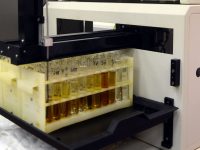Understanding Fourier Transform Infrared (FTIR) Spectroscopy
Fourier Transform Infrared (FTIR) spectroscopy measures additive depletion, contaminant buildup, and base stock degradation in lubricants. This type of analysis complements wear metal and other analyses.
The principle of the test is that an infrared absorbance spectrum is acquired by passing an infrared beam through a thin layer of static sample. The level of certain additives, contaminants, and degradation by-products can be determined by measuring the absorbance at key wavelengths. The results are typically reported as absorbance per centimeter (abs/cm), referring to how much of the infrared beam is absorbed at a specific wavelength, though often the values are treated as unitless or indexed values.
Routine FTIR results report four parameters:
- Oxidation mostly represents degradation of the fluid, but can also detect the presence of synthetic esters, which reveals some information regarding the base stock formulation. Oxidation products may increase the viscosity, acidity, and sludge/varnish formation in lubricants.
- Nitration indicates a build-up of nitration by-products, often originating from combustion by-products reacting with recirculated exhaust gas or blow-by. Nitration products may increase the viscosity, acidity, and insolubles level in lubricants.
- Antiwear measures degradation of the ZDDP additive. Since this additive is not used in all oil types, measured values must be compared to new oil reference values for the same fluid, or at least trended, as low results may be expected.
- Other Fluid indicates contamination with other products when this value increases from a new oil reference value.
Turbine method FTIR results report seven parameters:
- Thermal Event Acid measures degradation caused by high-temperature thermal events like electrostatic spark discharge or microdieseling.
- Acid Oxidation measures acids formed by degradation, though some acidic rust inhibitors may appear in new oil reference values. Increases in this parameter without increases in the Ester parameter could indicate oxidation in the presence of water.
- Ester measures fluid degradation products formed in the absence of water. Antifoam additives may appear in new oil reference values, as well as some synthetic ester base stock formulations.
- Aromatic Additive indicates the presence of an API Group I base stock, aromatic phosphorus additives, or a phenyl-a-naphthylamine (PANA) antioxidant additive.
- Base Oil Aromatic indicates the presence of olefins and aromatics, suggesting an API Group I base stock formulation.
- Amine Antioxidants measure the level of amine antioxidant additives, but not as accurate as the RULER test.
- Phenolic Antioxidants measure the level of phenolic antioxidant additives, but not as accurate as the RULER test.
In general, all FTIR parameters must be trended for proper evaluation, as “safe” or “alarm” levels could vary significantly from one fluid to another. All degradation parameters are expected to increase over time, and it is the rate at which they increase which can indicate a severe problem. All additive parameters are expected to remain relatively stable, or decrease slightly, with any significant increase likely indicating contamination with another product.


